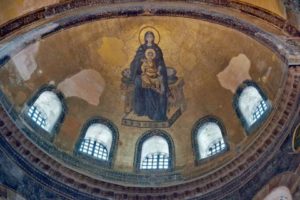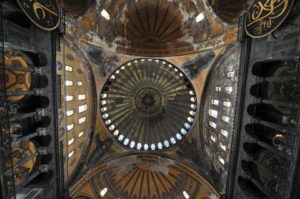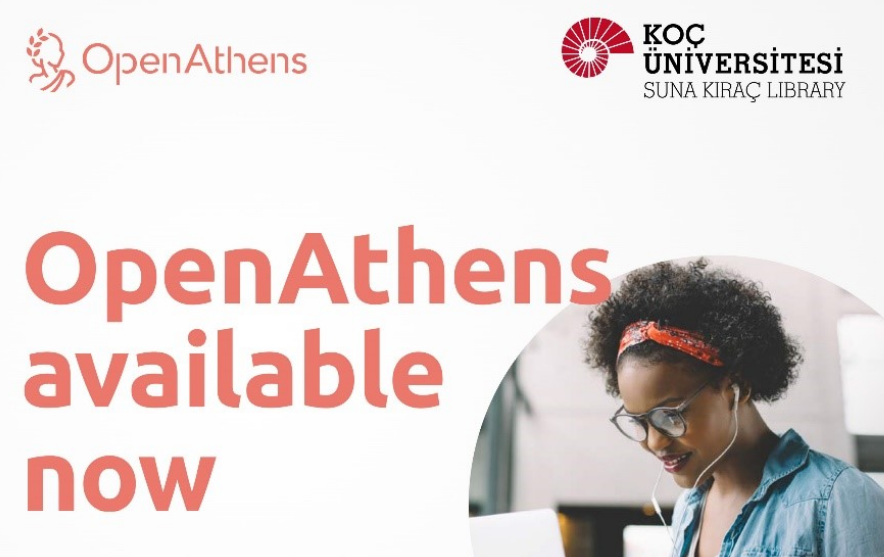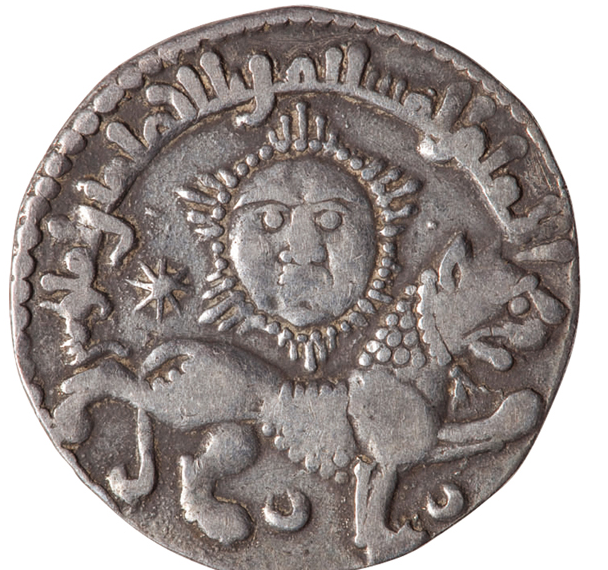“The church has been made a spectacle of great beauty, stupendous to those who see it and altogether incredible to those who hear of it..” Procopius
Think about yourself as a traveler and today’s modern tourist in Medieval period and you had a chance to see many of the most interesting and charming capitals around the world. However, one of them was named as the Queen of all cities: Constantinople was the capital city of the Byzantine Empire (330–1204 and 1261–1453). Constantinople was a silent witness of many catastrophizes, ceremonies, fires, games, wars through the history. The city also welcomed millions of people from different corners of the world who spoke different languages. Ambassadors like Liutprand of Cremona and Ruy Gonzalez de Clavijo, pilgrims like Nicholas, William of Boldensele, German priest Ludolf of Sudheim, Robert de Clari who was a knight from Picardy visited the Queen of cities with a different purpose each and in their own literal style they shared the beauties of the city in their journals, books, letters and memoirs.
When the visitors of Constantinople arrived to the city, the first thing they saw were the walls of the city. Then they began to experience the other beauties of it such as The Great Palace, the Hippodrome, the column of Justinian, the Palace of Boukoleon, the Main Street of the city called Mese and many others. Very different from the other buildings and monuments of the city, one that was the most valuable and desirable among all, was Hagia Sophia. Like today, even hundred years ago, Hagia Sophia was the most visited place by many travelers who liked its dimensions, richness and holiness.
The wonder of Constantinople was a perfect combination of maths-geometry with aesthetic. The richness of the church’s decoration and size were also mentioned many times in written sources. The Diegesis is also a legendary place. According to a tale which was told by English historians Radulphus De Diceto and Radulphus Niger in 12th century, during the construction of Hagia Sophia, miracles took place and the church even had a special Angel to guard it. Additionally, many visitors described details of the interior decoration of the church along with the gates and columns, for people who did not have the chance to see this heavenly building.
Hagia Sophia is best described with the words of travelers who see many different and exotic locations in the world. One of the travelers who visited Constantinople was Benjamin of Tudela, a medieval Jewish traveler. In his letters, he mentioned about sterling gold covered pillars and walls of the Palace of Blachernae, production of silk garments and cloths, the Hippodrome of Constantinople as the favorite entertainment place for inhabitants of Constantinople to watch horse races and finally the place of worship Hagia Sophia “all the other places of worship in the whole World do not equal Hagia Sophia in riches. It is ornamented by pillars of gold and silver and by innumerable lamps of the same precious materials…”.
Ibn Battuta, a medieval Moroccan traveler and scholar, also describes the impressive size and wealth of the building of Hagia Sophia with these words: “I will describe its exterior having not seen its interior. It was built by… the cousin of (Prophet) Solomon…It is one of the greatest churches of the Rum. It surrounded by walls, as if it were a city. Its gates are thirteen in number and it has a sacred enclosure. No one is prevented from entering the enclosure…It is like an audience hall paved with marble and traversed by a water stream…that flows between two walls constructed of marble inlaid with pieces of different colors and cut with the most skillful art.”
Another important traveler was Ali ibn Abi Bakr al-Harawi, a 12th and 13th century Persian traveler who wrote in his book called “Book of Wonders”: “Hagia Sophia which is their great church. The Byzantines say that an angel dwells therein and they made a gold railing around his location, which has a wonderous history and which we mention in its proper place. The layout of this church, its temple, elevation, doors, height, length width and pillars that it contains…This city is greater than its name!”.
Today, Hagia Sophia is standing as a symbol of wealth and aesthetic marvel and it is more pompous than other ordinary buildings around it. In 2018, inhabitants of Constantinople / İstanbul are celebrating the 1481th birthday of Hagia Sophia. Right now it is not an Orthodox church or Mosque in the Islamic world, it is one of the most important museums of Istanbul and is considered as a World Heritage Monument by UNESCO. It is the greatest surviving masterpiece of Byzantine architecture and it the greatest monument which carries the characteristics of these two different cultures in a perfect synthesis.
Bibliography – Resources from SKL and ANAMED Libraries
Benjamin, of Tudela. The world of Benjamin of Tudela : a medieval Mediterranean travelogue. Madison : Fairleigh Dickinson University Press, 1995. G370.B5 B4613 1995
Ciggaar, Krijna Nelly. Western travellers to Constantinople : the West and Byzantium, 962-1204 : cultural and political relations. Leiden ; New York : E.J. Brill, 1996. DF546 .C54 1996
Durak, Koray. “Ortaçağ’da Bizans’ın Komşularının Gözüyle Ayasofya Kilisesi (The Church of Hagia Sophia as Seen by the Neighbors of the Byzantine Empire),” Ayasofya Müzesi Yıllığı, no.13(2010): 231-248.
El-Cheikh, Nadia Maria. Byzantium viewed by the Arabs. Cambridge, Mass. : Distributed for the Center for Middle Eastern Studies of Harvard University by Harvard University Press, 2004. DF504.5 .E5 2004
Harawī, ʻAlī ibn Abī Bakr. A lonely wayfarer’s guide to pilgrimage : ʻAlī ibn Abī Bakr al-Harawī’s Kitāb al-Ishārāt ilā maʻrifat al-Ziyārāt. Princeton, N.J. : Darwin Press, 2004. BP187 .H3713 2004
Procopius. Procopius. Cambridge, Mass. : Harvard University Press, 2006. PA5340.A1 D49 2006
Vin, J. P. A. van der. Travellers to Greece and Constantinople : ancient monuments and old traditions in medieval travellers’ tales. Istanbul : Nederlands Historisch-Archaeologisch Instituut, 1980.
Schibille, Nadine. Hagia Sophia and the Byzantine aesthetic experience. Farnham Surrey, England ; Burlington, VT : Ashgate, 2014. NA5870.A9 S34 2014
Mainstone, R. J. Hagia Sophia : architecture, structure, and liturgy of Justinian’s great church. London : Thames and Hudson, 1988. NA5870.A9 M28 1988
Naz Özkan
Historian, Branch Librarian (ANAMED)





